Papers by Susan H McDaniel
Professional Psychology: Research and Practice, 2002
Primary care psychology is a growing field that requires specific training opportunities for succ... more Primary care psychology is a growing field that requires specific training opportunities for successful practice. The knowledge and skills that practitioners need for work in this setting are outlined here in detail. This curriculum integrates literature and experience in family psychology, health psychology, and pediatric psychology; considers multiple levels of education and training; and provides illustrative examples. It is a first attempt in an evolving process of integrating historical and cutting edge literature from many areas of psychology and other disciplines to contribute to comprehensive primary care psychology training. It can be used by programs and individual practitioners alike in designing education and training experiences.
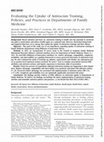
The Journal of the American Board of Family Medicine
Background: Recent attention and focus on, antiracism training in health care has potential to ac... more Background: Recent attention and focus on, antiracism training in health care has potential to accelerate our path to social justice and achieve health equity on a national scale. However, theoretical frameworks and empirical data have yet to emerge that explain the uptake of antiracism trainings and their efficacy. Objective: This goal of this study was to test hypotheses regarding uptake of antiracism training in Family Medicine departments using Diffusion of Innovation Theory. Methods: In 2021, we incorporated 10 survey items in the Council of Academic Family Medicine Educational Research Alliance's national omnibus survey for Department of Family Medicine Chairs (n = 104). We used DOI (Diffusion of Innovation) attributes (ie, relative advantage, compatibility, complexity, trialability, and observability) as a guiding framework to assess perceived innovation of antiracism training. We also evaluated the mode of training (eg, didactic, experiential) and whether any subsequent policy or practice-level antiracist actions occurred. We used c 2 tests to examine associations between DOI attributes and antiracist actions; and logistic regression to determine odds of association. Results: Ninety-two percent of respondents indicated antiracism training was happening in their department. Relative advantage, compatibility and observability were positively associated with antiracist actions, P < .05. Perceived relative advantage was associated with implementation of antiracist action (OR 1.94, 1.27-2.99). Complexity and trialability were not statistically significantly associated with action. Conclusion: Our findings provide evidence of DOIs influence on antiracism uptake in Departments of Family Medicine. We believe our findings can facilitate the future implementation of antiracism training activities and actionable antiracist policies and practices.
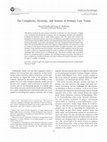
American Psychologist, 2018
This article examines the past, present and future of primary care and teamwork. It begins with a... more This article examines the past, present and future of primary care and teamwork. It begins with a definition and description of primary care-its uniqueness, diversity and complexity, including the historical role of teams within primary care. The article then reviews the emergence of innovative primary care teams, including those grounded in new processes such as the Patient-Centered Medical Home and interprofessional teams that include new types of health professionals, particularly psychologists and other integrated behavioral health clinicians. The article describes key factors that support or hinder primary care teamwork, as well as evidence of the impact of these team-based models on patient outcomes, costs, and team members. It also discusses the role of primary care teams within multiteam systems (or 'teams of teams'), which are organized around the needs of patients and families, and the unique challenges these systems pose to coordinating care. The article concludes with recommendations for advancing teams in primary care, including changes in payment, descriptions of team competencies, models for primary care team training, and research necessary to inform the gaps in scientific knowledge.
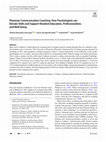
Journal of Clinical Psychology in Medical Settings, 2021
Many factors influence resident physician communication, including rigorous training demands that... more Many factors influence resident physician communication, including rigorous training demands that can contribute to professionalism issues or burnout. The University of Rochester Physician Communication Coaching program launched for attendings in 2011, and expanded to residency programs within 11 clinical departments of our institution. In this model, psychologists serve as coaches, drawing on their expertise in communication skills, behavior change, and wellness promotion. These coaches conduct real-time observation of patient encounters, coding communication with an expanded Cambridge-Calgary Patient-Centered Observational Checklist. Residents receive a written report with individualized feedback. From 2013 to 2020, 279 residents were coached. Since 2018, residents have been formally surveyed for feedback (n = 70 surveys completed; 61% response rate), with 97% rating the experience Very Helpful or Helpful. Of the 70 completed surveys, 54 (77%) included qualitative feedback that has also been positive. Due to the feasibility and growing demand for communication coaching from other residency and fellowship programs, in 2018 two authors (SM and LD-R) developed a 2-year, part-time program to train communication coaches.
American Academy of Pediatrics eBooks, Mar 10, 2011
Casebook for integrating family therapy: An ecosystemic approach.
... Susan H. McDaniel, Jennifer L. Harkness, and Ronald M. Epstein ... My first contact with this... more ... Susan H. McDaniel, Jennifer L. Harkness, and Ronald M. Epstein ... My first contact with this case was at a collo-quium organized to bring together family therapists from Psychiatry and Family Medicine with biopsy-chosocially oriented physicians, including George Engel ...
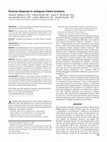
Journal of General Internal Medicine, 2005
OBJECTIVE: To examine how primary care physicians respond to ambiguous patient symptom presentati... more OBJECTIVE: To examine how primary care physicians respond to ambiguous patient symptom presentations. DESIGN: Observational study, using thematic analysis within a larger cross-sectional study employing standardized patients (SPs), to describe physician responses to ambiguous patient symptoms and patterns of physician-patient interaction. SETTING: Community-based primary care offices within a metropolitan area. PARTICIPANTS: Twenty-three primary care physicians (internists and family physicians). METHOD: Participating physicians had 2 unannounced SP visits randomly inserted into their daily practice schedules and the visits were audiotaped and transcribed. A coding system focusing on physician responses to concerned patients presenting with ambiguous symptoms was developed through an inductive process. Thematic analyses were then applied to coded data. RESULTS: Physicians' responses to ambiguous symptoms were categorized into 2 primary patterns: high partnering (HP) and usual care (UC). HP was characterized by greater responsiveness to patients' expression of concern, positivity, sensitivity to patients' clues about life circumstances, greater acknowledgment of symptom ambiguity, and solicitation of patients' perspectives on their problems. UC was characterized by denial of ambiguity and less inclusion of patients' perspectives on their symptoms. Neither HP physicians nor UC physicians actively included patients in treatment planning. CONCLUSIONS: Primary care physicians respond to ambiguity by either ignoring the ambiguity and becoming more directive (UC) or, less often, by acknowledging the ambiguity and attempting to explore symptoms and patient concerns in more detail (HP). Future areas of study could address whether physicians can learn HP behaviors and whether HP behaviors positively affect health outcomes.
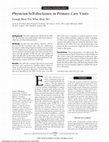
Archives of Internal Medicine, 2007
Background: The value of physician self-disclosure (MD-SD) in creating successful patient-physici... more Background: The value of physician self-disclosure (MD-SD) in creating successful patient-physician partnerships has not been demonstrated. Methods: To describe antecedents, delivery, and effects of MD-SD in primary care visits, we conducted a descriptive study using sequence analysis of transcripts of 113 unannounced, undetected, standardized patient visits to primary care physicians. Our main outcome measures were the number of MD-SDs per visit; number of visits with MD-SDs; word count; antecedents, timing, and effect of MD-SD on subsequent physician and patient communication; content and focus of MD-SD. Results: The MD-SDs included discussion of personal emotions and experiences, families and/or relationships, professional descriptions, and personal experiences with the patient's diagnosis. Seventy-three MD-SDs were identified in 38 (34%) of 113 visits. Ten MD-SDs (14%) were a response to a patient question. Fortyfour (60%) followed patient symptoms, family, or feelings; 29 (40%) were unrelated. Only 29 encounters (21%) returned to the patient topic preceding the disclosure. Most MD-SDs (n=62; 85%) were not considered useful to the patient by the research team. Eight MD-SDs (11%) were coded as disruptive.
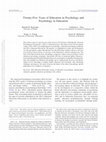
The American psychologist, 2017
This article is part of a special issue of the American Psychologist celebrating the American Psy... more This article is part of a special issue of the American Psychologist celebrating the American Psychological Association's (APA's) 125th anniversary. The article reviews the last quarter century (1991-2016) of accomplishments by psychology's education and training community and APA's Education Directorate. The purpose is to highlight key trends and developments over the past quarter century that illustrate ways the Directorate sought to advance education in psychology and psychology in education, as the Directorate's mission statement says. The focus of the Directorate has been on building a cooperative culture across psychology's broad education and training community. Specifically APA has (a) promoted quality education-from prekindergarten through lifelong learning, (b) encouraged accountability through guidelines and standards for education and training, and (c) supported the discovery and dissemination of new knowledge to enhance health, education, and wel...
Canadian family physician Médecin de famille canadien, 1991
Somatic fixation occurs when the patient or physician focuses exclusively on the biomedical aspec... more Somatic fixation occurs when the patient or physician focuses exclusively on the biomedical aspects of a complex illness. Individual, family, and cultural factors promote the expression of emotional experience through physical symptoms. The physician or treatment team establishes a collaborative relationship with the patient and family, integrating biomedical and psychosocial evaluations and respecting the patient's defenses.
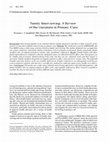
Family medicine, 2002
Interviewing families is an essential skill for family physicians, but there is little research o... more Interviewing families is an essential skill for family physicians, but there is little research on the process or outcomes of family interviewing in primary care. We conducted a search of MEDLINE and PsychINFO using a wide range of terms related to family interviewing. The studies obtained were grouped into one of four categories: physicians' family orientation or level of family involvement, family genograms, family members who accompany patients to routine visits, and family conferences. Family history and other family information are commonly collected, and family issues are often discussed in office visits. Genograms can be reliably and accurately obtained during brief visits, but they are not commonly used, and their impact is uncertain. Family members frequently accompany patients to office visits and serve various roles. The potential benefits and risks of these visits are not fully understood. Family conferences are infrequently used but are well accepted by patients and...

Collaborative Medicine Case Studies, 2008
We sat behind the one-way mirror watching a couple in pain. Helen was in her early 60 s, frail on... more We sat behind the one-way mirror watching a couple in pain. Helen was in her early 60 s, frail on the outside but with an obvious inner strength. She was hunched slightly in the chair, visibly uncomfortable, holding ice packs on her neck. She struggled to turn her head to look at her husband, Elliot, while he talked, her range of motion severely constrained by chronic, intractable pain in her neck and back. Elliott, in his late 60 s, sat next to her. While both agreed he was the healthier and stronger of the two, both also quietly agreed he was suffering, vulnerable, and in pain himself. Elliott sat tall in his chair, active and expressive with his hands while he spoke. "Do they cut the nerve or don't they?" he asked to no one in particular, seeming almost impervious. "I'm overwhelmed…it's like I'm working two jobs, you know?" The couple seemed comfortable in the therapy room; it was a familiar place with familiar, supportive listeners. We (T.R. and D.M.) are postdoctoral fellows in medical family therapy and primary care family psychology, respectively. We both completed internships in primary care settings, and pursued fellowships at the University of Rochester to receive additional training in collaborative care with the faculties of the Departments of Family Medicine, Psychiatry, and Medicine. We were invited by an expert team of collaborative cotherapists to observe their work with two sets of couples around a complex matrix of biopsychosocial issues. Though this was not the beginning of therapy, which had started some 14 years earlier, it was also not the end. As observers, we witnessed firsthand the value of transgenerational family treatment delivered by a family physician-family psychologist pair, focusing on physical, behavioral, and relational health issues. This chapter represents our observations, a case study of two generations of couples from the same family, struggling with the same themes of somatic complaints, mood disorders, family loyalty, and role negotiations as couples. We focus on the transgenerational transmission of somatizing issues and also of gender roles and expectations, roles and responsibilities. We will also highlight the unique structure of the therapies. Both couples were treated by the same cotherapists: Susan McDaniel, a psychologist with training in family therapy and collaborative care, and Kevin Fiscella, a family physician with training in family therapy. Their collaboration represented a balance in motion for these two couples with complex physical, emotional, and relational health issues.

Family members are the key source of social, emotional and financial assistance for people with d... more Family members are the key source of social, emotional and financial assistance for people with disabilities throughout their lives. However, the role of the family undergoes significant changes in different periods of the life of people with disabilities. During childhood, adolescence, adulthood and old age, people with disabilities need other forms of support, which means that they undertake educational, professional or family activities related to starting their own families and bringing up children. Around that time, their relationship with the family is changing. The role of the family is becoming limited in the area of control and assistance in making life choices for people with disabilities. Our goal will be to reconstruct the family's presence in social networks of adults and to identify socio-demographic and emotional factors that affect the number of contacts with the family. This will be the starting point for presenting the impact of family relationships on strengthening empowerment and promoting self-determination among adults with disabilities. The analysis will be based on data from Social Diagnosis 2015.
Family Medicine, 2003
... One must 26 Thomas L. Campbell, Susan H. McDaniel, Kathy Cole-Kelly Page 12. ... An essential... more ... One must 26 Thomas L. Campbell, Susan H. McDaniel, Kathy Cole-Kelly Page 12. ... An essential com-ponent of joining is making some positive contact with each person present so that each feels valued and connected enough to the physi-cian to participate in the interview. ...
The Family in Medical Practice, 1987
Family Medicine, 1998
Patients often present symptoms and problems to a family physician that are largely related to st... more Patients often present symptoms and problems to a family physician that are largely related to stress experienced in the family context. Patients, though, seldom identify family stress as a source of the symptoms they are experiencing. The challenge for the family physician is to accurately assess the role that family stress plays in a patient’s symptoms and decide what interventions are most appropriate and effective. These tasks require the physician to, first, use a biopsychosocial approach to patients with particular attention to the role family may play in the patient’s problems; second, assess the family dynamics that may be contributing to the patient’s difficulties; and third, decide if the degree of family difficulty is amenable to primary care counseling or must be referred to a family-oriented mental health professional.
Professional Psychology: Research and Practice, 2002

Journal of Marital and Family Therapy, 1992
This paper reports a study of 63 initial interviews of structural-strategic therapy with families... more This paper reports a study of 63 initial interviews of structural-strategic therapy with families with child-focused problems. These interviews were analyzed to determine differences in the process of therapy between male and female therapists. We tested specifically for differences in joining and executive skills between male and female therapists. Transcripts made from audiotapes of the interviews were coded with the Therapeutic Interaction Coding System (TICS). Thirtyseven cases completed therapy, and 26 dropped out of therapy against therapists' advice. There were no significant differences in male and female therapists' case completion rates. The overall level of supportive statements was not significantly different between males and females. Family members made more structuring or directive statements toward male therapists, but stated more disagreement with other family members when their therapist was female. Male therapists made more explanation statements than female therapists in response to family members' structuring or disagreement statements. I n addition, we tested for differences in activity level and found that male therapists made more statements overall than did female therapists. Much has been written recently about gender issues in family therapy, particularly with regard to therapists' values (Hines & Hare-Mustin, 19801, the reification of the traditional family in family therapy theory (James











Uploads
Papers by Susan H McDaniel